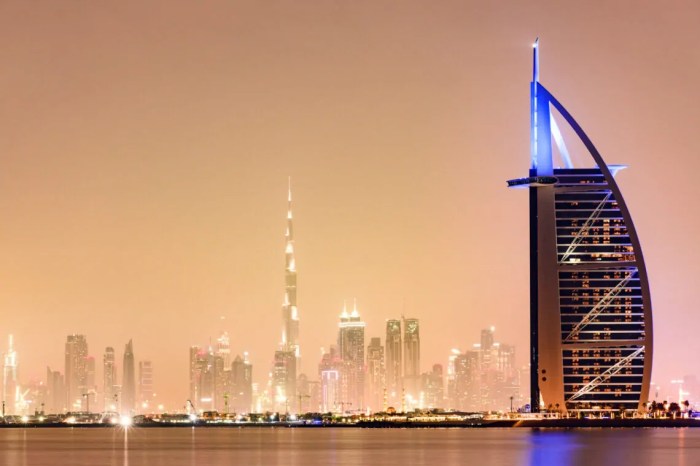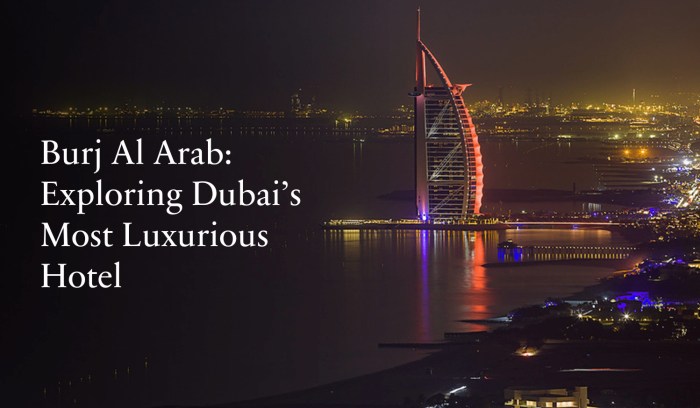Dive into the world of Burj Al Arab, a symbol of luxury and innovation in Dubai’s skyline. From its fascinating history to breathtaking design, this gem has much to offer for curious minds.
History of Burj Al Arab

Burj Al Arab, the iconic sail-shaped building in Dubai, has a rich history that dates back to the late 1990s, when the idea for this magnificent structure was conceived.
Timeline of Key Events
- 1994: Conceptualization of Burj Al Arab begins
- 1996: Construction officially commences
- 1999: Burj Al Arab is completed and opens its doors to the public
Inspiration Behind the Design
The design of Burj Al Arab was inspired by the sail of a dhow, a traditional Arabian sailing vessel. This unique and innovative design was the brainchild of architect Tom Wright, who wanted to create a structure that would symbolize the modern and progressive nature of Dubai.
Significance in Dubai’s Architectural Landscape
Burj Al Arab stands as a symbol of Dubai’s ambition and vision for the future. Its striking design and luxurious amenities have helped put Dubai on the map as a global destination for luxury and innovation in architecture. The Burj Al Arab has become an iconic landmark that represents the city’s rapid development and transformation into a world-class metropolis.
Architecture and Design
Burj Al Arab’s sail-shaped structure is one of its most iconic features, standing tall at 321 meters with a distinct resemblance to a ship’s sail. The design was conceptualized by architect Tom Wright, and the building is often referred to as the “Sail of Dubai” due to its unique shape.The design elements of Burj Al Arab reflect the maritime heritage of Dubai in several ways.
The sail-shaped structure pays homage to the city’s history as a major port and trading hub, symbolizing the connection between Dubai’s past and its modern identity as a global luxury destination. Additionally, the interior of the hotel is inspired by the sea, with a color palette of blue and gold, and intricate design details reminiscent of waves and marine life.Compared to other iconic structures around the world, Burj Al Arab stands out for its innovative and daring architectural style.
While buildings like the Eiffel Tower or the Sydney Opera House are known for their unique designs, Burj Al Arab’s sail-shaped silhouette and luxurious amenities set it apart as a symbol of modern Dubai’s ambition and extravagance.
Interior Design and Luxury
As you step into the Burj Al Arab, you are immediately enveloped in a world of luxury and opulence that is truly unmatched. The interior design of this iconic hotel is a masterpiece in itself, boasting extravagant elements that leave guests in awe.
Opulent Interior Design Elements
- The use of lavish materials such as gold leaf accents, marble floors, and intricate mosaics create a sense of grandeur throughout the hotel.
- The stunning atrium with a cascading waterfall and vibrant colors sets the tone for a luxurious experience from the moment you enter.
- The lavish suites are adorned with plush furnishings, rich fabrics, and handcrafted details that exude elegance and sophistication.
Luxurious Amenities and Services
- Guests at Burj Al Arab have access to a private beach, chauffeur-driven Rolls Royce service, and a team of dedicated butlers to cater to their every need.
- The hotel’s award-winning restaurants offer a culinary experience like no other, with world-renowned chefs creating exquisite dishes using the finest ingredients.
- The Talise Spa provides a sanctuary for relaxation and rejuvenation, with treatments and facilities that pamper guests in a truly indulgent setting.
Contribution to Guest Experience
- The interior design of Burj Al Arab plays a crucial role in enhancing the overall guest experience, creating a sense of exclusivity and luxury that is unparalleled.
- Every detail, from the sumptuous furnishings to the exquisite decor, is meticulously curated to ensure that guests feel like royalty during their stay.
- The luxurious amenities and services offered further elevate the guest experience, providing a level of comfort and sophistication that exceeds all expectations.
Sustainability and Environmental Initiatives
When it comes to sustainability and environmental initiatives, the Burj Al Arab has made significant efforts to reduce its impact on the environment.
Sustainable Practices
- During construction, the building used environmentally friendly materials and implemented energy-efficient systems to minimize its carbon footprint.
- Efforts were made to reduce water consumption through innovative technologies like water-saving fixtures and greywater recycling.
- The hotel also focuses on waste management, recycling materials whenever possible and implementing composting programs.
Environmental Certifications
The Burj Al Arab has been awarded various environmental certifications, such as the Green Globe certification, which recognizes its commitment to sustainable practices and environmental responsibility.
Impact on Ecosystem and Community
- The construction and operation of the Burj Al Arab have had both positive and negative impacts on the surrounding ecosystem and community.
- Positive impacts include job creation, economic growth, and increased tourism revenue for the region.
- Negative impacts may include increased energy consumption, waste generation, and potential disruption to local wildlife habitats.
Epilogue

In conclusion, Burj Al Arab stands tall as a beacon of architectural brilliance, melding opulence with sustainability to create an unforgettable experience for all who visit.